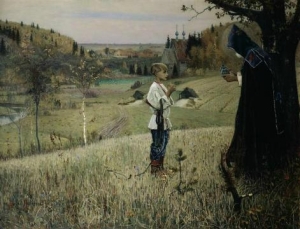Moscu +7-495-505-63-25
St. Petersburg +7-812-309-57-60
Galeria Estatal Tretyakov
Excursions with State Tretyakov Gallery
Lavrushinsky Lane, 10

The National Museum of Russian Fine Art, the State Tretyakov Gallery, is one of the largest museums in the world. Its collections embrace the period from the 10th to 20th century and all schools of Russian painting — from ancient icons to avant-guard.
Pavel Mikhailovich Tretyakov, a rich Moscow merchant and textile mill owner, started collecting Russian paintings in the 1850s. It was then he bought several works by Russian artists and it was then the Tretyakovs moved to their new estate in the Lavrushinsky Lane — the mansion that would become a world famous museum.
Tretyakov who conceived the creation of the public gallery comprehensively representing the history of Russian fine art bought pictures relying only on his taste. He was one of the first who highly appreciated old Russian icons, systematically bought the works of the old masters and was greatly interested in contemporary art. Quite often Tretyakov who became a prominent figure in the cultural life of Russia acquired paintings strongly criticized or banned by censorship. He was considered such an authority that if any work of an artist got in his collection, for the latter it was equal to public acknowledgement.
Since the early 1870s Tretyakov became a friend of the so-called Itinerant Artists. The founder of the picture gallery not only shared their principles and ideas but also supported the movement. He eagerly bought their works and gathered an unmatched collection that features paintings by Perov, Maksimov, Makovsky, Pryanishnikov, Kramskoy, Shishkin, Polenov, Repin, and Surikov.
In the late 1860s Tretyakov inspired by the popular at the time enlightenment idea of the prominent role of the personality in the history conceived the creation of the portrait gallery of the outstanding Russian culture and art figures. The collector bought ready portraits of Russian writers, composers and artists and also ordered portraits from contemporary artists. It is interesting that Tretyakov himself couldn't stand posing for a portrait and throughout his lifetime made exceptions only twice — for artists Kramskoy and Repin.
From year to year Tretyakov's collection grew. The house in Lavrushinsky Lane became too small to host it and was then rebuilt. New constructions were attached and the picture gallery was enlarged. And although officially the Gallery was privately owned it acquired the status of the museum. Anyone despite his rank and social status could visit it on any day of the week.
In August, 1892 Tretyakov presented the collection and the Gallery to the city of Moscow. Until his death Tretyakov supported the gallery and bought a number of masterpieces of Russian art. The number of paintings and graphics acquired during that period was 220. The last big purchase he made for the Gallery was The Bogatyrs by Vasnetsov. In 1898 Tretyakov died. After his death a new facade designed by Vasnetsov was attached to the old estate. This Russian styled facade became the symbol of the Gallery.
Already in the early 20th century the Tretyakov Gallery became the most popular and visited museum of that day. Soon after the revolution of 1917 the Gallery was nationalized and its collection was enriched with paintings from the expropriated private collections and abolished museums.
By the end of the 20th century the State Tretyakov Gallery became one of the world richest treasuries of Russian fine art. The Gallery treasures priceless collection of old Russian icons, paintings, sculptures and graphics of the 18th-20th centuries.
Besides the main Russian styled building in Lavrushinsky Lane the State Tretyakov Gallery got a new museum complex in Krymsky Val. The exposition of the branch museum is totally dedicated to the Russian art of the 20th century. There regularly temporary thematic exhibitions and the exhibitions of contemporary art are hold.
Nearest hotels
Baltschug-Kempinski
Calle Balchug, 1
El hotel Balchug Kempinski Moscú se encuentra en la orilla del Moskova, enfrente del Kremlin, lo que es
de 162.72
por noche
President
Calle Bolshaya Yakimanka, 24
En 1982 en la orilla del Moscova, en el mismo centro administrativo y de negocios de la capital, apareció el hotel de
de 0
por noche
Park Inn Sadu
17, B.Polyanka str., bld.1
The Park Inn Sadu hotel belonged to Park Inn hotel net was opened in Moscow. The hotel is ideally situated in the
de 0
por noche
Alrosa
1ro Kazachy Carril, 4
El hotel Alrosa se encuentra en la ciudad de Moscú, en algunos minutos a pie del Kremlin y una gran cantidad de
de 0
por noche
Salut
158 Leninsky Pr.
Salut hotel is located in South-West part of Moscow at the intersection of Leninsky and Vernandsky prospects, within
de 0
por noche
Atracciones de Moscu
- Monuments
































